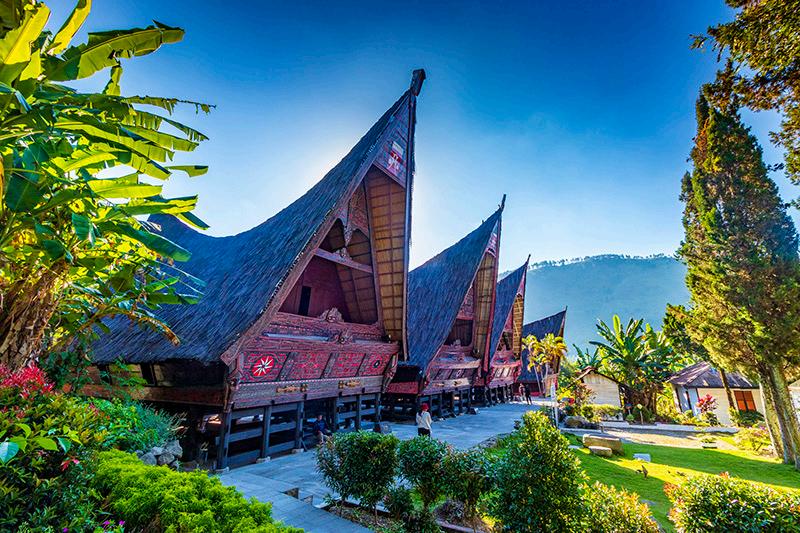Nestled within the quiet landscape of Bakkara Valley, surrounded by the sacred waters of Lake Toba and guarded by green hills, stands a modest yet powerful structure: the Istana Raja Sisingamangaraja—the royal palace of the legendary Batak king, Sisingamangaraja XII. This isn’t a grand, gold-plated palace like you’d find in Java or Bali. It’s something deeper. More spiritual. A wooden fortress of resilience, identity, and untold stories.
To the untrained eye, it might look like an old traditional house. But once you understand its history and meaning, you’ll realize: this is the soul of Batak resistance and pride.
📜 A Palace Carved in Heritage, Not Marble
The palace is located in Bakkara, in Baktiraja District, right on the western banks of Lake Toba, where the Sisingamangaraja dynasty ruled for generations. It’s not one single building, but rather a royal compound, built in the traditional “Ruma Bolon” style—wooden architecture with steep, horn-shaped roofs and intricate carvings that reflect Batak cosmology.
These houses were not just homes—they were political headquarters, religious sanctuaries, and war councils during the centuries of Batak self-rule before the arrival of the Dutch.
👑 Who Was Sisingamangaraja XII?
Let’s talk about the man behind the legend. Sisingamangaraja XII, born in 1849, was the last king in a sacred lineage of priest-kings (Raja Imam) in Batak culture. More than just royalty, he was considered a spiritual leader, believed to be divinely guided. His leadership wasn’t just political—it was cosmic.
But what cemented his legacy was his resistance.
Starting in the late 1800s, as Dutch colonial forces began encroaching into the Batak Highlands, Sisingamangaraja XII led a series of guerrilla campaigns against them. For over 25 years, he resisted Dutch colonization with a combination of spiritual leadership, military strategy, and alliances with other anti-colonial leaders like Tuanku Imam Bonjol.
He never surrendered. In fact, he died in battle in 1907 in Dairi Regency—shot while protecting his son, making him one of Indonesia’s national heroes (Gelar Pahlawan Nasional sejak 1961).
🏛️ Inside the Palace: What You’ll See
Today, the Istana Raja Sisingamangaraja is preserved as a cultural heritage site, managed by local Batak communities and occasionally supported by regional tourism boards. It’s not a museum in the modern sense—but that’s part of its charm. When you step inside, you feel like time slows down.
Key highlights:
-
Ruma Bolon: Traditional wooden house elevated on stilts, showcasing Batak architectural genius—no nails, only wooden pegs and interlocking joints.
-
Historical relics: Spears, swords, ulos fabrics, and ritual items believed to be used by the royal family.
-
Sacred symbols: The gorga carvings (red-black-white motifs) represent protection, fertility, and connection to the ancestors.
-
Grave of Sisingamangaraja XII: Nearby, you can visit the makam (tomb) of the king, which is a place of pilgrimage for many Batak people.
Don’t expect a polished, commercialized place—this is a living heritage. The air smells of old wood and incense. Locals still treat the area with spiritual respect.
🧭 Why It Matters (More Than Ever)
In a time where globalization has blurred cultural lines, places like the King Sisingamangaraja Palace act as an anchor—a reminder of where Batak culture came from, and what it stood for. This isn’t just about nostalgia. It’s about preserving identity.
The palace tells us that:
-
Indigenous leadership systems existed long before Indonesia was a country.
-
Resistance didn’t only come from Java—it also roared from the hills of Sumatra.
-
Culture, spirituality, and politics were once inseparable in Batak life.
For young generations of Batak people, this site is a call to reconnect with their roots. For Indonesians in general, it’s a lesson in unity and diversity. And for foreign tourists? It’s a unique glimpse into a lesser-known chapter of anti-colonial history.
🛤️ How To Visit
-
Location: Desa Simamora, Baktiraja, Kabupaten Humbang Hasundutan, Sumatra Utara
-
Entry: Often free, though donations are appreciated to help with preservation.
-
Best Time to Visit: Dry season (May–October) for better access and clearer skies over Lake Toba.
-
Combine With: A visit to Bakkara Valley, Aek Sipangolu spring, and Janji Waterfall nearby.
✨ Final Thoughts: A Palace Without a Crown, But Full of Spirit
The Istana Sisingamangaraja doesn’t shout. It whispers. It tells stories of a time when leaders didn’t wear suits, but ulos. When loyalty wasn’t written in contracts, but sworn beside waterfalls. When war wasn’t only about territory, but about preserving the soul of a people.
If you’re looking to understand Batak identity, you won’t find it in shopping malls or five-star resorts. You’ll find it here, carved in wood, protected by tradition, and still echoing with the footsteps of a king who never gave up.



